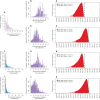Timing the SARS-CoV-2 index case in Hubei province
- PMID: 33737402
- PMCID: PMC8139421
- DOI: 10.1126/science.abf8003
Timing the SARS-CoV-2 index case in Hubei province
Abstract
Understanding when severe acute respiratory syndrome coronavirus 2 (SARS-CoV-2) emerged is critical to evaluating our current approach to monitoring novel zoonotic pathogens and understanding the failure of early containment and mitigation efforts for COVID-19. We used a coalescent framework to combine retrospective molecular clock inference with forward epidemiological simulations to determine how long SARS-CoV-2 could have circulated before the time of the most recent common ancestor of all sequenced SARS-CoV-2 genomes. Our results define the period between mid-October and mid-November 2019 as the plausible interval when the first case of SARS-CoV-2 emerged in Hubei province, China. By characterizing the likely dynamics of the virus before it was discovered, we show that more than two-thirds of SARS-CoV-2-like zoonotic events would be self-limited, dying out without igniting a pandemic. Our findings highlight the shortcomings of zoonosis surveillance approaches for detecting highly contagious pathogens with moderate mortality rates.
Copyright © 2021 The Authors, some rights reserved; exclusive licensee American Association for the Advancement of Science. No claim to original U.S. Government Works.
Figures




Update of
- Timing the SARS-CoV-2 Index Case in Hubei Province.bioRxiv [Preprint]. 2020 Nov 24:2020.11.20.392126. doi: 10.1101/2020.11.20.392126.bioRxiv. 2020.Update in: Science. 2021 Apr 23;372(6540):412-417. doi: 10.1126/science.abf8003.PMID: 33269353Free PMC article.Updated.Preprint.
Similar articles
- Timing the SARS-CoV-2 Index Case in Hubei Province.bioRxiv [Preprint]. 2020 Nov 24:2020.11.20.392126. doi: 10.1101/2020.11.20.392126.bioRxiv. 2020.Update in: Science. 2021 Apr 23;372(6540):412-417. doi: 10.1126/science.abf8003.PMID: 33269353Free PMC article.Updated.Preprint.
- The molecular epidemiology of multiple zoonotic origins of SARS-CoV-2.Science. 2022 Aug 26;377(6609):960-966. doi: 10.1126/science.abp8337. Epub 2022 Jul 26.Science. 2022.PMID: 35881005Free PMC article.
- Evolutionary study of COVID-19, severe acute respiratory syndrome coronavirus 2 (SARS-CoV-2) as an emerging coronavirus: Phylogenetic analysis and literature review.Vet Med Sci. 2021 Mar;7(2):559-571. doi: 10.1002/vms3.394. Epub 2020 Nov 18.Vet Med Sci. 2021.PMID: 33210477Free PMC article.Review.
- SARS-CoV-2 variants evolved during the early stage of the pandemic and effects of mutations on adaptation in Wuhan populations.Int J Biol Sci. 2021 Jan 1;17(1):97-106. doi: 10.7150/ijbs.47827. eCollection 2021.Int J Biol Sci. 2021.PMID: 33390836Free PMC article.Review.
- Zoonotic and Reverse Zoonotic Transmissibility of SARS-CoV-2.Virus Res. 2021 Sep;302:198473. doi: 10.1016/j.virusres.2021.198473. Epub 2021 Jun 9.Virus Res. 2021.PMID: 34118360Free PMC article.Review.
Cited by
- Molecular Evolution of SARS-CoV-2 during the COVID-19 Pandemic.Genes (Basel). 2023 Feb 4;14(2):407. doi: 10.3390/genes14020407.Genes (Basel). 2023.PMID: 36833334Free PMC article.Review.
- SARS-CoV-2 shows a much earlier divergence in the world than in the Chinese mainland.Sci China Life Sci. 2023 Jun;66(6):1440-1443. doi: 10.1007/s11427-023-2294-5. Epub 2023 Mar 7.Sci China Life Sci. 2023.PMID: 36897494Free PMC article.No abstract available.
- FRET-based hACE2 receptor mimic peptide conjugated nanoprobe for simple detection of SARS-CoV-2.Chem Eng J. 2022 Aug 15;442:136143. doi: 10.1016/j.cej.2022.136143. Epub 2022 Mar 31.Chem Eng J. 2022.PMID: 35382003Free PMC article.
- Emergence of epidemic diseases: zoonoses and other origins.Fac Rev. 2022 Jan 18;11:2. doi: 10.12703/r/11-2. eCollection 2022.Fac Rev. 2022.PMID: 35156099Free PMC article.Review.
- Uncertainty Modeling of a Modified SEIR Epidemic Model for COVID-19.Biology (Basel). 2022 Aug 2;11(8):1157. doi: 10.3390/biology11081157.Biology (Basel). 2022.PMID: 36009784Free PMC article.
References
- Zhu N., Zhang D., Wang W., Li X., Yang B., Song J., Zhao X., Huang B., Shi W., Lu R., Niu P., Zhan F., Ma X., Wang D., Xu W., Wu G., Gao G. F., Tan W.; China Novel Coronavirus Investigating and Research Team , A novel coronavirus from patients with pneumonia in China, 2019. N. Engl. J. Med. 382, 727–733. (2020). 10.1056/NEJMoa2001017 - DOI - PMC - PubMed
- Li Q., Guan X., Wu P., Wang X., Zhou L., Tong Y., Ren R., Leung K. S. M., Lau E. H. Y., Wong J. Y., Xing X., Xiang N., Wu Y., Li C., Chen Q., Li D., Liu T., Zhao J., Liu M., Tu W., Chen C., Jin L., Yang R., Wang Q., Zhou S., Wang R., Liu H., Luo Y., Liu Y., Shao G., Li H., Tao Z., Yang Y., Deng Z., Liu B., Ma Z., Zhang Y., Shi G., Lam T. T. Y., Wu J. T., Gao G. F., Cowling B. J., Yang B., Leung G. M., Feng Z., Early transmission dynamics in Wuhan, China, of novel coronavirusinfected pneumonia. N. Engl. J. Med. 382, 1199–1207. (2020). 10.1056/NEJMoa2001316 - DOI - PMC - PubMed
- World Health Organization, Report of the WHO-China Joint Mission on Coronavirus Disease 2019 (COVID-19) (World Health Organization, 2020); www.who.int/publications/i/item/report-of-the-who-china-joint-mission-on....
- Fei H., Yinyin X., Hui C., Ni W., Xin D., Wei C., Tao L., Shitong H., Miaomiao S., Mingting C., Keshavjee S., Yanlin Z., Chin D. P., Jianjun L., The impact of the COVID-19 epidemic on tuberculosis control in China. Lancet Reg. Health West. Pac. 3, 100032 (2020). 10.1016/j.lanwpc.2020.100032 - DOI - PMC - PubMed
- World Health Organization, WHO Director-Generals opening remarks at the media briefing on COVID-19 - 11 March 2020 (World Health Organization, 2020); www.who.int/director-general/speeches/detail/who-director-general-s-open....
Publication types
MeSH terms
Associated data
Grants and funding
LinkOut - more resources
Full Text Sources
Other Literature Sources
Medical
Miscellaneous

